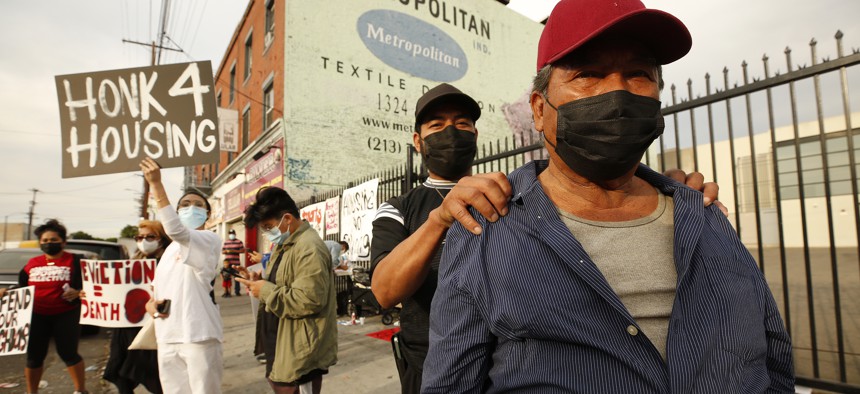How Partnerships Can Lead to Emergency Rental Assistance Program Success

Getty Images/Al Seib
COMMENTARY | With most eviction moratoriums expiring, millions of renters are in dire need of assistance. Strategic partnerships can expand capacity through outreach and application intake and processing.
This story was first published by the Urban Institute. Click here to read the original version.
Twenty-two months after much of the country shut down at the start of the Covid-19 crisis, renters remain disproportionately affected by the economic fallout. Even before the pandemic, many renters were cost burdened, struggling with high rents and stagnant wages—especially Black, Latinx, and Indigenous renters, who have been hardest hit by the health and economic impacts of Covid-19.
With the end of the federal eviction moratorium and expiring state and local eviction protections, millions of renters are at risk of losing their homes as the pandemic continues. As of December 2, only 18% of renter households lived in jurisdictions with some form of eviction moratorium.
And a new report from the Eviction Lab at Princeton University finds that although they remain below pre-pandemic levels, evictions have been on the rise since the federal moratorium’s end, particularly in states and cities with little to no legal protections.
The crisis underscores the urgent need to get Emergency Rental Assistance to those at risk. The U.S. Department of the Treasury is the federal administrator for two ERA programs: ERA1 provides up to $25 billion under the Consolidated Appropriations Act of 2021, and ERA2 provides up to $21.55 billion under the American Rescue Plan Act. But some states and localities have been slow to administer assistance.
What’s Impeding ERA Distribution?
According to the National Low Income Housing Coalition’s Treasury ERA Dashboard, 54.6% of ERA1 ($13.6 billion) and 12.2% of ERA2 ($2.63 billion) have been approved or paid to households.
One challenge states and localities face is the capacity to scale up the infrastructure necessary to administer ERA funding. Running an effective rental assistance program means hiring staff, developing policies and procedures, building an application process, and establishing partnerships.
Outside of rental assistance, rental subsidies, and rapid rehousing programs administered by public housing authorities and continuum of care administrators, few jurisdictions had robust pre-pandemic rental assistance programs.
From what the Treasury has reported and what we’ve learned as we provide technical assistance to states and localities, we find the jurisdictions that have been able to scale up more quickly already had programs, partnerships, and other infrastructure in place.
Community Organizations Can Help Fill Gaps
Strategic partnerships with community-based organizations have been critically important to the success of ERA programs, helping jurisdictions expand capacity through community outreach and application intake and processing.
In North Carolina, local nonprofits and CBOs are helping jurisdictions reach more residents and process more applications. Charlotte and Mecklenburg County partnered with DreamKey Partners, a local CBO committed “to helping families see what is possible with an affordable home,” to provide emergency relief to those affected by Covid-19. As of August 31, 2021, Charlotte had distributed 98% ($23.6 million) of its ERA funding, and Mecklenburg County had distributed 100% ($6.7 million).
In Ohio, which has distributed 14.3% ($1.06 billion) of combined ERA1 and ERA2 funding, the ERA program is administered through a network of 47 nonprofits providing a range of other social services. In Clark County; Las Vegas; North Las Vegas; and Henderson, Nevada, the CARES Housing Assistant Program works through a network of local nonprofit organizations.
In both states, nonprofits and CBOs use a common online data system for application intake, processing, and tracking. Working collaboratively and sharing responsibilities can also help alleviate capacity issues and burnout.
Your Way Home, Montgomery County, Pennsylvania’s coordinated housing crisis response system, partnered with six CBOs across the county to make ERA more accessible, especially for people without access to a computer or internet. In an interview, county leaders said these CBOs were critical in equitable community outreach and engagement, providing culturally and linguistically competent services to the county’s hardest-hit areas and connecting applicants with relevant services and programs.
As of October 31, 2021, Montgomery County had assisted 4,282 households and distributed 77% ($17.1 million) of its ERA1 funding and 56% ($5.5 million) of its ERA2 funding.
San Antonio, Texas, partnered with 20 local health-care nonprofits with a history of serving local Latinx communities. Leveraging existing relationships between CBOs and their clients can help overcome distrust of the government and reluctance to apply without a personal connection. With their deep community ties, these organizations were well positioned to address these barriers.
Working Together to Stabilize Communities
Many local governments have faced difficulties administering equitable, effective, and efficient ERA programs that distribute funding quickly and reach households most at risk of eviction or housing instability, but some have found success through partnerships with CBOs. CBOs can help scale up a jurisdiction’s capacity to connect with community members most in need, process applications, and monitor application statuses.
Local government–CBO partnerships could also improve homelessness prevention programs and other care services in the long run. Partnerships provide opportunities to tap into others’ expertise, learn from their experiences, and develop new solutions together.
Communities can continue to leverage these partnerships in the development of preventive practices and services and improve housing stability long after ERA funds are gone.





